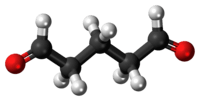Glutaraldehyde
| | |
 | |
| Names | |
|---|---|
| Preferred IUPAC name
Pentanedial[1] | |
| Other names
Glutaraldehyde Glutardialdehyde Glutaric acid dialdehyde Glutaric aldehyde Glutaric dialdehyde 1,5-Pentanedial | |
| Identifiers | |
| 111-30-8 | |
| 3D model (Jmol) | Interactive image |
| ChemSpider | 3365 |
| DrugBank | DB03266 |
| ECHA InfoCard | 100.003.506 |
| KEGG | D01120 |
| PubChem | 3485 |
| UNII | T3C89M417N |
| |
| |
| Properties | |
| C5H8O2 | |
| Molar mass | 100.117 |
| Appearance | Clear liquid |
| Odor | pungent[2] |
| Density | 1.06 g/mL |
| Melting point | −14 °C (7 °F; 259 K) |
| Boiling point | 187 °C (369 °F; 460 K) |
| Miscible, reacts | |
| Vapor pressure | 17 mmHg (20°C)[2] |
| Hazards | |
| Flash point | noncombustible[2] |
| US health exposure limits (NIOSH): | |
| PEL (Permissible) |
none[2] |
| REL (Recommended) |
C 0.2 ppm (0.8 mg/m3)[2] |
| IDLH (Immediate danger) |
N.D.[2] |
| Except where otherwise noted, data are given for materials in their standard state (at 25 °C [77 °F], 100 kPa). | |
| | |
| Infobox references | |
Glutaraldehyde is an organic compound with the formula CH2(CH2CHO)2. A pungent colorless oily liquid, glutaraldehyde is used as a sterilisation agent and preservative. It is mainly available as an aqueous solution, and in these solutions the aldehyde groups are hydrated.[3]
Uses
Sterilization and biocidal action
Virtually all applications of glutaraldehyde exploit its high reactivity toward proteins. Being nonvolatile and bifunctional, glutaraldehyde is often preferred to the less expensive formaldehyde. It reacts with amines, amides, and thiol groups in proteins.[4]
A glutaraldehyde solution of 0.1% to 1.0% concentration may be used as a biocide for system disinfection and as a preservative for long term storage. It is a sterilant, killing endospores in addition to many microorganisms and viruses.[5]
Glutaraldehyde is a component of hydraulic fracturing "fracking" fluid. It is included in the additive called Alpha 1427, as a biocide.[6] Bacterial growth can impair the production of oil and gas wells, and can be introduced into the formation from various sources including the source water, proppant, and polymers used in the hydraulic fracturing process. Glutaraldehyde is pumped as a liquid additive with the fracturing fluid to reduce or eliminate this source of formation and fracture conductivity damage.
Fixative
Glutaraldehyde is used in biochemistry applications as an amine-reactive homobifunctional crosslinker and fixative prior to SDS-PAGE, staining, or electron microscopy. It kills cells quickly by crosslinking their proteins and is usually employed alone or mixed with formaldehyde[7] as the first of two fixative processes to stabilize specimens such as bacteria, plant material, and human cells. A second fixative procedure uses osmium tetroxide to crosslink and stabilize cell and organelle membrane lipids. Fixation is usually followed by dehydration of the tissue in ethanol or acetone, followed by embedding in an epoxy resin or acrylic resin.
Another application for treatment of proteins with glutaraldehyde is the inactivation of bacterial toxins to create toxoid vaccines, e.g., the pertussis (whooping cough) toxoid component in the Boostrix Tdap vaccine produced by GlaxoSmithKline.[8]
In a related application, glutaraldehyde is sometimes employed in the tanning of leather and in embalming.
Wart treatment
A solution of glutaraldehyde, typically of 10% w/w, is sold under various trade names to remove common and plantar warts. It is said to inactivate viruses and bacteria, and to dry the skin, facilitating physical removal of the wart.[9] Trade names include Diswart Solution and Glutarol.
Safety
As a strong sterilant, glutaraldehyde is toxic and a strong irritant.[10] There is no evidence of carcinogenic activity.[11]
Production and structure

Glutaraldehyde is produced industrially by the oxidation of cyclopentene and by the Diels-Alder reaction of acrolein and methyl vinyl ether followed by hydrolysis.[3]
Like other dialdehydes (e.g., glyoxal), it does not exist as the dialdehyde in water, but as the hydrate. These hydrates adopt several equilibrating species.[12]
Monomeric glutaraldehyde can polymerize by aldol condensation reaction yielding alpha, beta-unsaturated poly-glutaraldehyde. This reaction usually occurs at alkaline pH values.
References
- ↑ Nomenclature of Organic Chemistry : IUPAC Recommendations and Preferred Names 2013 (Blue Book). Cambridge: The Royal Society of Chemistry. 2014. p. 907. doi:10.1039/9781849733069-FP001. ISBN 978-0-85404-182-4.
- 1 2 3 4 5 6 "NIOSH Pocket Guide to Chemical Hazards #0301". National Institute for Occupational Safety and Health (NIOSH).
- 1 2 Christian Kohlpaintner, Markus Schulte, Jürgen Falbe, Peter Lappe, Jürgen Weber (2005), "Aldehydes, Aliphatic", Ullmann's Encyclopedia of Industrial Chemistry, Weinheim: Wiley-VCH, doi:10.1002/14356007.a01_321.pub2
- ↑ H. Uhr, B. Mielke, O. Exner, K. R. Payne, E. Hill (2005), "Biocides", Ullmann's Encyclopedia of Industrial Chemistry, Weinheim: Wiley-VCH, doi:10.1002/14356007.a16_563.pub2
- ↑ HCC lecture notes, 15: Control of microrganisms
- ↑ Morgantown Utility Board. "Fracking Fluid Additives - Fracking Fluid MSDS's".. Links to documents, including Alpha 1427 Material Safety Data Sheet
- ↑ Karnovsky, M.J. (1965). A formaldehyde-glutaraldehyde fixative of high osmolality for use in electron microscopy. Journal of Cell Biology 27: 137A–138A
- ↑ Boostrix prescribing information, ©2009, GlaxoSmithKline
- ↑ NHS Choices: Glutarol
- ↑ Canadian Centre for Occupational Health and Safety (CCOHS) (a federal government site) > OSH Answers > Diseases, Disorders & Injuries > Asthma Document last updated on February 8, 2005
- ↑ Toxicology and Carcinogenesis Studies of Glutaraldehyde
- ↑ Whipple Earl B.; Ruta Michael (1974). "Structure of Aqueous Glutaraldehyde". J. Org. Chem. 39: 1666–1668. doi:10.1021/jo00925a015.
External links
- National Pollutant Inventory - Glutaraldehyde Fact Sheet
- National Institute for Occupational Safety and Health - Glutaraldehyde
- NIST WebBook
- Glutaraldehyde at OpenWetWare (the life science wiki)
